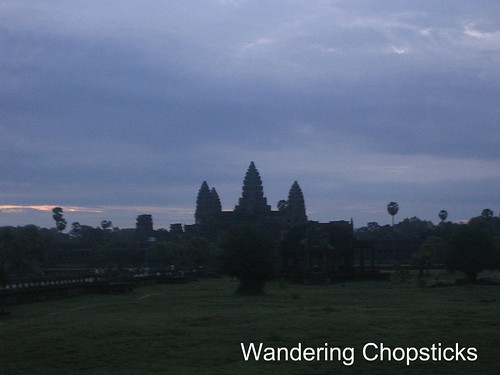
Angkor was the capital of the Cambodian/Khmer empire from the 9th to 15th century, according to Wikipedia. The word Angkor comes from the Sanskrit word nagara (city). The Angkorian period began in 802 AD, when Jayavarman II declared himself "god-king" of Cambodia, and ended in 1431, when the capital was sacked by the Siamese. Apsara dancers, priests, and artisans were carted off. The Khmers then abandoned Angkor and moved the capital to Phnom Penh.
Today, the Angkor Archaeological Park administers about a hundred major temples and other buildings in an area 15 miles wide by 5 miles long, but also includes sites 30 miles away such as Kbal Spean. There were an estimated 1,000 buildings, but many of them are lost to the jungle or reduced to rubble. During Angkorian times, the area around the temples was approximately 1,150 square miles (3,000 square kilometers), about the size of Los Angeles, making it the largest pre-industrial complex of its kind. For comparison, the next largest sprawling complex is the 50-square mile Mayan city of Tikal. At its height, Angkor had a population of 1 million people. Again for comparison, at the time Paris only had 50,000 inhabitants.
Since it's pretty much impossible to sum up everything into one post, I'd encourage you to read the History of Cambodia for a better understanding of the pre-Angkorian civilizations of Funan and Chenla, and post-Angkorian history including French colonialism and the Khmer Rouge era. For more descriptive details about each building, The Angkor Guide is a translation of Maurice Glaize's 1944 guide. The buildings were built with a combination of brick, sandstone, and laterite, which you can read more about in architecture of Cambodia for a discussion of building materials, techniques, and styles. I hope the quick summary gives you a glimpse into the importance and majesty of Angkor.
In trying to write about my trip, I found it really hard to describe the immense scale of the whole complex and how the buildings related to each other. I took a couple of pictures of illustrations from the May 1982 and August 2000 issues of National Geographic so you can get a better idea of what I'm talking about. To sustain such a massive population in the pre-industrial world, the Angkorians built countless canals that redirected water from nearby Tonle Sap Lake. The Western and Eastern Barays were man-made reservoirs with temples in the center that can only be visited by boat. The Eastern Baray, which once held 50 million cubic meters of water, is now dry, but the Western Baray is still intact. The bottom square in the illustration below is Angkor Wat. The square in the middle is Angkor Thom, which I'll get to in the next post. Driving around, I can remember seeing water everywhere. Despite the crowds of tourists, the fact that this was all man-made more than a thousand years ago, and seeing that it yet still survives today was simply awe-inspiring.
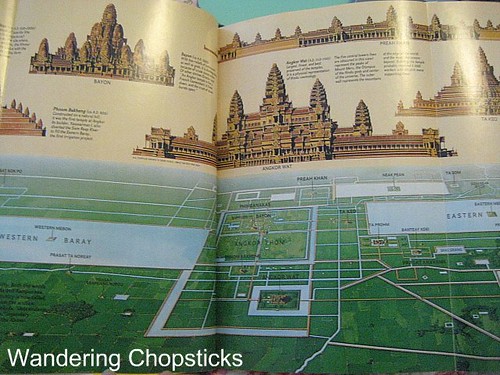
The largest and most well-known of all the buildings is Angkor Wat, a source of such national pride that it has appeared on the Cambodian national flag since 1863. King Suryavarman II built the temple in the early 12th century as his state temple and capital city. Wat or vat means temple. It was first built as a Hindu temple to the god Vishnu and then in the 14th or 15th century was converted to Theravada Buddhist use, which continues today.
Angkor Wat is surrounded by a moat, with an outer wall of 2.2 miles (3.6 kilometers) and three rectangular galleries which are each elevated above the next. In the middle are five towers, designed to represent Mount Meru, home of the gods in Hindu myth. Unlike the other temples, Angkor Wat faces the west, and scholars have debated whether this means it was meant to serve as the king's funerary temple.
OK, so was that enough background information for you? To recap my adventure so far, on a Friday afternoon, two of my friends and I flew from Saigon to Siem Reap. We spent the first night at Koulen Restaurant with a buffet dinner and Khmer classical and folk dance show.
Then *yawn* at our tour guide's suggestion, we woke up at *yawn* 5 a.m. on a Saturday to watch the sunrise over Angkor Wat.
*Yawn*
*Yawn*
Sunrise over Angkor Wat would have been totally worth it...
...if it wasn't July...
...and thus...
...the rainy season.
So instead of seeing darkness turn into gold as the sun rose over the majestic towers...
...the sky just turned lighter...
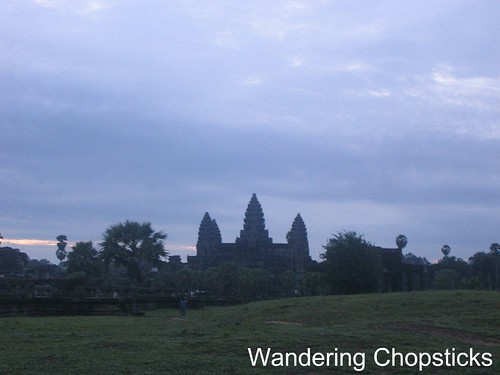
...and lighter...

...and lighter.
*Yawn*
Really?!
That's it?!
I got up at 5 a.m. for this?!
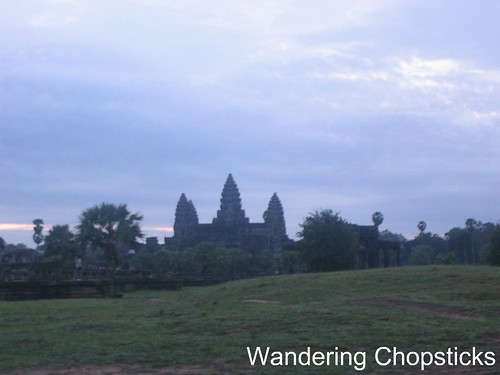
OK, to talk about immense scale again, look at the walkway to the left of the picture above. Now look at the National Geographic picture below. See the far right arrow where I stood to watch the sunrise? That's a long, long walk to actually enter the temple. Also note the other arrow for the lotus pond, which I'll show you later. (Actually, upon looking at my pictures, I realized it's a waterlily pond but I'm too lazy to edit the photo again.)
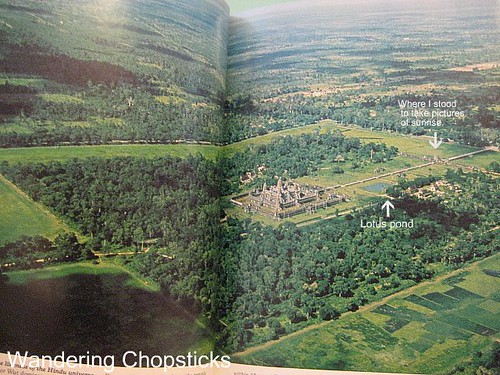
The arrow pointing to where I watched the sunrise was this building below. *Yawn* And even at 5 a.m., apparently other tourists' tour guides told them they, too, needed a photo of the sunrise.

And apparently, these tourists were told the same thing. I hear it's even more of a madhouse to capture the sunset.

Here's the most frequently photographed spot of Angkor Wat, over the waterlily pool. There's supposed to be another waterlily pool on the other side, but if I recall correctly, it was all dried up.
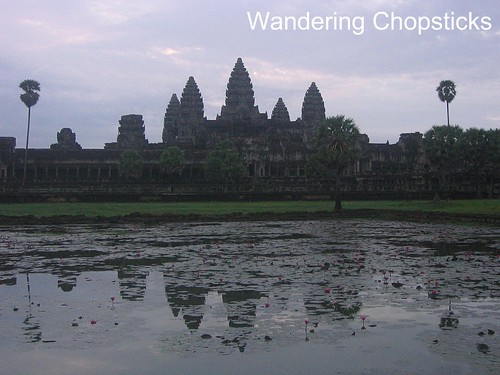
So pretty isn't it? I have a photo of me right in front of this spot. The view is so stunning that it looks like I faked it and photoshopped myself over the image.
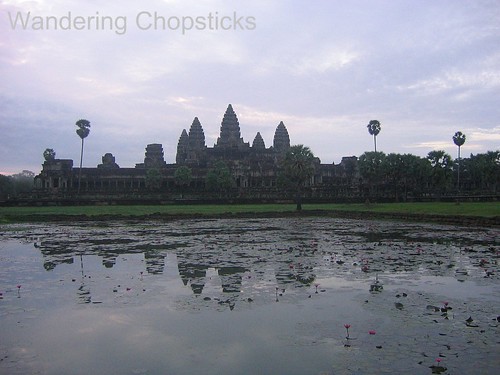
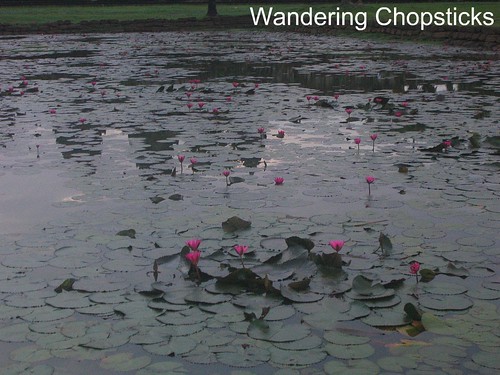
Let's go inside, shall we? Remember what I said about rings of galleries that gradually elevated? My friends and I entered from the right side shown in the photo, walked around one of the outer galleries, and then climbed up and up until we got to the top tower.

This was one of those outer galleries.
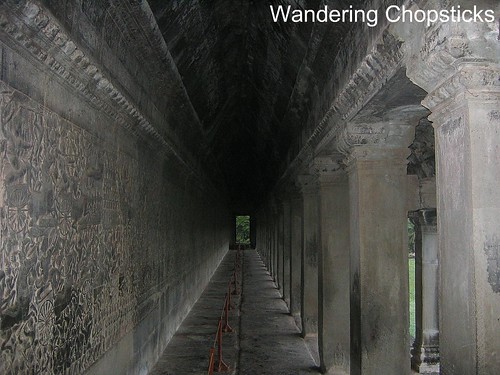
Depicting a battle that I've long-since forgotten so if anyone knows, feel free to drop a note.
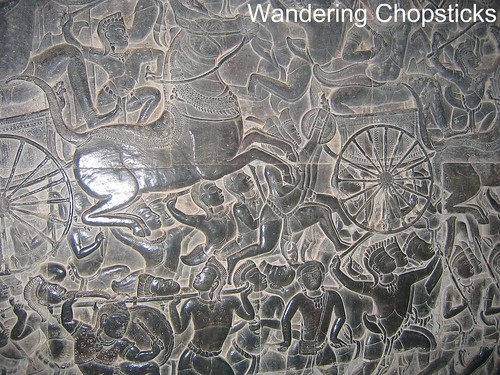
Seriously, every wall was intricately carved. I wasn't nearly as diligent in capturing all of them, so for more descriptions and photos, check out Kirk of Mmm-yoso's post. Apsara dancers. And notice the carved wall to her left?
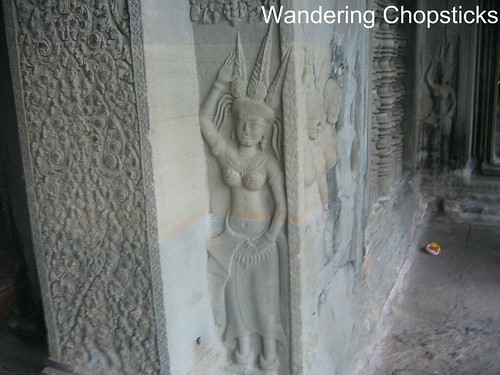
Look closely and you can see another dancer.
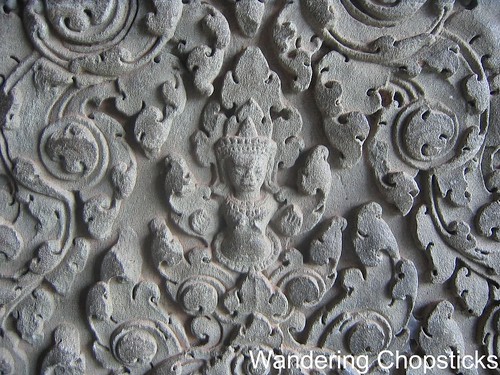
I just liked this scene of a mother picking up her baby.
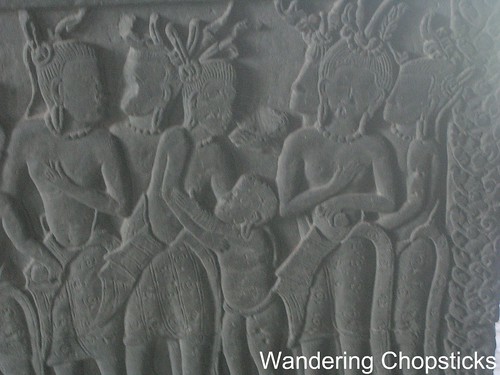
Now we start walking toward the central tower. The stairs were very steep, between 45 and 70 degrees, with very high steps. The act of climbing the central tower is supposed to be akin to ascending heaven.
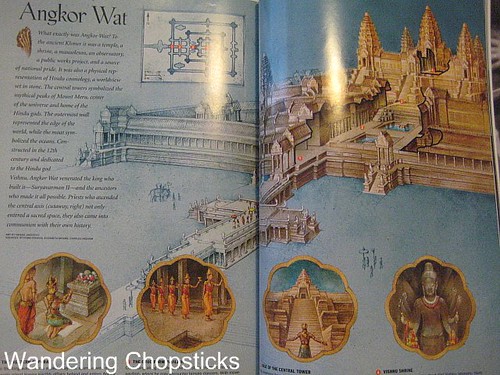
I think the central tower must have been 70 degrees because it felt vertical to me. I seriously climbed the steps using my arms as if I were rock-climbing. But I'll spare you the photo of my backside.
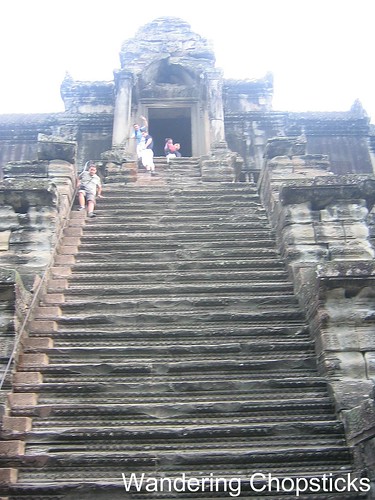
Descending was very scary, even with the aid of the recently installed handrail and additional steps.
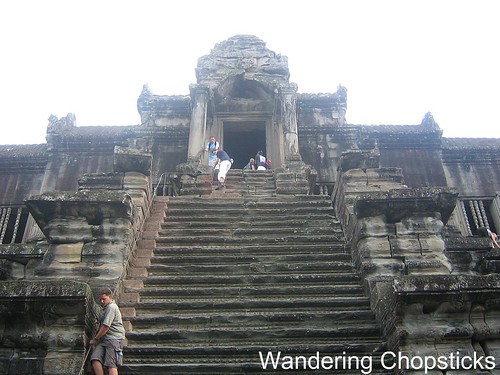
Whoohoo! I climbed Mount Meru. I'm the pink blob on top. :)
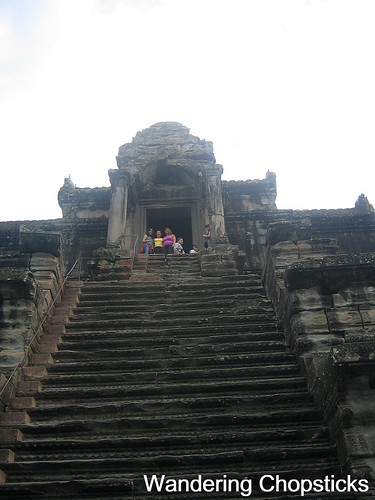
We spent several hours at Angkor Wat, so by the time we were done, our guide suggested we go back to the hotel for our free breakfast and a nap, since we got up so early. He said he'd come back for us at 10 a.m. to take us to the next temple.
Next stop was Angkor Thom.
Here's a map to Angkor Archeological Park so you can get an idea of where buildings are in relation to each other.
For the nitty-gritty details: If you'd like to explore the Angkor ruins, I used All Asia Travel, which prices according to number of people in your party. My standard tour package, which in 2005 was about $150 per person for three people, included hotel for two nights and three days, breakfast, air-conditioned car and driver, English-speaking tour guide, and entrance fees to Angkor Archaeological Park. The airfare from Saigon to Siem Reap was a separate $200 on Vietnam Airlines but they booked the flight for us.
It's a less than one hour flight from Saigon to Siem Reap, so if you've got a free weekend and you're already in Vietnam, I'd highly encourage a visit.
My friends and I decided to go with All Asia Travel because it was less expensive than any of the other small tour packages that we saw in Saigon, and yet still offered a lot of amenities. One of my friends only had a single-entry visa for Vietnam, and they arranged for another visa for her upon landing back in Saigon. I really liked the individual tour since we didn't have to wait on any other tourists. Also, with just us, we could see as much or as little as we wanted. Trust me, after a day of seeing ruin after ruin, all the temples started congealing in our minds.
Our tour guide was named James, so you can ask for him if he's still around. He was very knowledgeable, if a bit chatty at times. I'm not sure how standard it was, but his suggestion of a nap after touring Angkor Wat was just the thing we needed. We also took another nap in the late afternoon after visiting several other temples and eating lunch. It was during the rainy season so it rains every afternoon. James was attuned enough to know exactly when that happens so we were back at our hotel for the downpour, and ready to go out again when it was over.
If you don't want to go with a tour package, I didn't use them so I can't vouch for them, but Canby Publications has a pretty thorough list with descriptions of going rates for hiring a tour guide, taxi, hotels, etc. The Canby website also has an informative breakdown of each temple's history and architectural influence. According to the website, the going rate for driver and tour guide are $20 to $25 each person, per day. One of my friends hired a guide at the airport and said he paid $80 for the weekend.
Entrance fees to Angkor Archaeological Park are $20 for a 1-day pass, $40 for a 3-day pass, and $60 for a 7-day pass. Though the grounds are immense, there are ticket-takers at the entrance to all major temples so you can't just sneak in.
You need to apply for a Cambodian visa to enter the country, which costs $20 USD. This can be applied for and processed upon landing at the airport.
If you didn't book a package, when you exit the airport, there are plenty of people holding signs so you can negotiate for your own driver and tour guide. If you don't want an air-conditioned car (It's usually a Toyota Camry.), there are also tuk-tuks, which have covered roofs but are open-air. There are also bike rentals but I'm serious when I said the grounds are immense.
I don't recall the name of the hotel, but the standard package hotel's triple room had three twin beds, clean sheets and towels, air-conditioning, television, bathroom with shower and tub, bathroom toiletries, and breakfast. If you want more than that, All Asia Travel also offers a variety of deluxe packages. My brother (who went separately but also that summer) stayed at the Shinta Mani, which he said was a very nice boutique hotel. His package also had breakfast, but he got a fresh coconut drink and Cambodian scarf upon arrival, and facials. The middle '87, who spent a weekend exploring Angkor while she was studying abroad in Singapore, did it for cheap by getting a friend of a friend to serve as tour-guide and staying in a rather sketchy hotel. So really, it's all up to you.
Drop a note if you've got any more questions.
I suggest reading my Cambodia series in this order:
Dith Pran and the Killing Fields Memorial in Siem Reap - Cambodia
Khmer Classical Dance at Koulen Restaurant - Siem Reap - Cambodia
Angkor Wat
Angkor Thom: Victory Gate, Bayon Temple, Terrace of the Leper King, Terrace of the Elephants, Prasats Suor Prat, and Phimeanakas
Ta Prohm
Chong Kneas Floating Village - Tonle Sap (Great Lake) - Cambodia
For a related post on Cambodian food: Battambang Seafood Restaurant - San Gabriel
*****
1 year ago today, Southern fried chicken, sour cream mashed potatoes, and cream gravy. So good one of my cousins skipped going to the beach in order to help me move just so he could get some.

oh! what a beautiful temple.My initial visit to AngKor Wat when I was back in Msia weeks ago,but family advise me not to go there since I'm travelling wt my 3 year old daughter.They said it's hard for us to climb the stairs at the temple.hmmmm...what do you think?.Maybe next year when we go back to Msia we can visit Angkor Wat.I know the Airasia is so cheap!!"sob..sob"..I wanna to go there!!
ReplyDeletedid you enjoy the service provided to you by your tour company? how large was the tour group and how much did it cost? would you recommend it to others?
ReplyDeletearen't all the temples just beautiful. I wish some people would be more considerate and don't be a litter bug to help preserve the beauty of the place.
ReplyDeleteBeachlover,
ReplyDeleteI was really quite exhausted climbing those steps. I'm not sure you'd want to do that with a 3-year-old! It's definitely worth a visit someday!
Vincent,
Questions are now all addressed in the post.
Savvy Gal,
I wish so too. I also wished other tourists wouldn't be so loud. It's hard to enjoy the ruins when others are laughing and talking loudly.